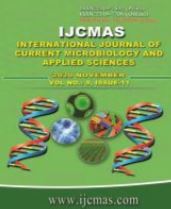


 National Academy of Agricultural Sciences (NAAS)
National Academy of Agricultural Sciences (NAAS)

|
PRINT ISSN : 2319-7692
Online ISSN : 2319-7706 Issues : 12 per year Publisher : Excellent Publishers Email : editorijcmas@gmail.com / submit@ijcmas.com Editor-in-chief: Dr.M.Prakash Index Copernicus ICV 2018: 95.39 NAAS RATING 2020: 5.38 |
Brinjal shoot and fruit borer (BSFB) (Leucinodes arbonalis Guenee) is an obnoxious pest causing severe yield loss to an extent of 70-92% and rendering the fruits unmarketable and unfit for consumption. Although a number of insecticides can effectively manage the pest, unethical and injudicious spray of insecticides causes pest resurgence, health hazards and pesticide residues in edible fruits. The present study focused on ETL based application of 3 insecticides imidacloprid 17.8 SL, spinosad 45 SC and carbofuran 3G, one botanical, Nimbicidine @ 0.03% EC and mechanical method of clipping infected shoots and fruits after every 10 days interval during Kharif 2017 and 2018. The treatment with Imidacloprid 17.8 SL proved to be the best with per cent pest reduction of as high as 75% and highest per cent yield increase of 77.81%. Moreover, spinosad 45 SC yielded 65.70% more yield than control in the second year, followed by Carbofuron 3G (56.84%), Nimbicidine @ 0.03% EC (54.75%) and manual clipping (25.84%). While, in the first year too, the similar trend of per cent yield increase and per cent pest reduction was recorded. Finally it was concluded that Imidocloprid 17.8 SL was the most efficient insecticide against BFSB and was recommended to be used in rotation with spinosad 45 SC, carbofuran 3G and Nimbicidine @ 0.03% EC to avoid resistance development and in integration with regular clipping of infected shoots and fruits to achieve successful pest management.
 |
 |
 |
 |
 |